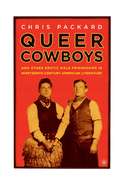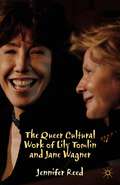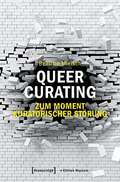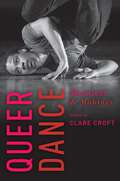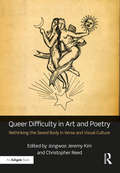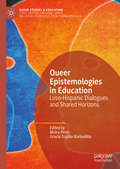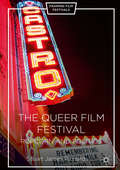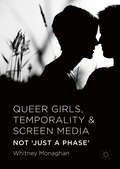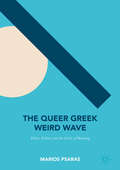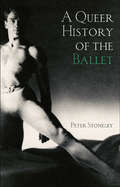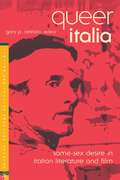- Table View
- List View
Queer cinema in contemporary France: Five directors (French Film Directors Series)
by Todd ReeserJacques Martineau, Olivier Ducastel, Alain Guiraudie, Sébastien Lifshitz and Céline Sciamma. The films of these five major French directors exemplify queer cinema in the twenty-first century. Comprehensive in scope, Queer cinema in contemporary France traces the development of the meaning of queer across these directors’ careers, from their earliest, often unknown films to their later, major films with wide international release. Whether having sex on the beach or kissing in the high school swimming pool, these cinematic characters create or embody forward-looking, open-ended and optimistic forms of queerness and modes of living, loving and desiring. Whether they are white, beur or black, whether they are lesbian, gay, trans* or queer, they open up hetero- and cisnormativity to new ways of being a gendered subject.
Queer cinema in contemporary France: Five directors (French Film Directors Series)
by Todd ReeserJacques Martineau, Olivier Ducastel, Alain Guiraudie, Sébastien Lifshitz and Céline Sciamma. The films of these five major French directors exemplify queer cinema in the twenty-first century. Comprehensive in scope, Queer cinema in contemporary France traces the development of the meaning of queer across these directors’ careers, from their earliest, often unknown films to their later, major films with wide international release. Whether having sex on the beach or kissing in the high school swimming pool, these cinematic characters create or embody forward-looking, open-ended and optimistic forms of queerness and modes of living, loving and desiring. Whether they are white, beur or black, whether they are lesbian, gay, trans* or queer, they open up hetero- and cisnormativity to new ways of being a gendered subject.
Queer Communism and The Ministry of Love: Sexual Revolution in British Writing of the 1930s
by Glyn Salton-CoxTracks the sublime art movement from Kant to the 21st century and onwards to a new future
Queer Communism and The Ministry of Love: Sexual Revolution in British Writing of the 1930s (Edinburgh University Press)
by Glyn Salton-CoxMaps materiality's importance in the emergent posthuman future of architecture
Queer Cowboys: And Other Erotic Male Friendships in Nineteenth-Century American Literature
by C. PackardWhy do the earliest representations of cowboy-figures symbolizing the highest ideals of manhood in American culture exclude male-female desire while promoting homosocial and homoerotic bonds? Evidence from the best-known Western writers and artists of the post-Civil War period - Owen Wister, Mark Twain, Frederic Remington, George Catlin - as well as now-forgotten writers, illustrators, and photographers, suggest that in the period before the word 'homosexual' and its synonyms were invented, same-sex intimacy and erotic admiration were key aspects of a masculine code. These males-only clubs of journalists, cowboys, miners, Indian vaqueros defined themselves by excluding femininity and the cloying ills of domesticity, while embracing what Roosevelt called 'strenuous living' with other bachelors in the relative 'purity' of wilderness conditions. Queer Cowboys recovers this forgotten culture of exclusively masculine, sometimes erotic, and often intimate camaraderie in fiction, photographs, illustrations, song lyrics, historical ephemera, and theatrical performances.
The Queer Cultural Work of Lily Tomlin and Jane Wagner
by J. ReedLily Tomlin and Jane Wagner have been partners in life and work for more than 40 years. Over those years they have been comedic pioneers in television, sound recording, film, theater, and animation. This book explores the ways they have used and expanded notions of queer to make their unique impact on American culture.
Queer Curating - Zum Moment kuratorischer Störung (Edition Museum #44)
by Beatrice MierschDieses Buch ist für alle, die mutig genug sind, sich selbst und das Zeigen von Kunst zu stören. Beatrice Miersch entwirft radikal-relationale Alternativen zu zeitgenössischen Ausstellungspraktiken. Um sich der gesellschaftlichen Verantwortung im Rahmen des Ausstellens von Kunst zu stellen, erprobt sie queer-feministische, kulturwissenschaftliche und selbstreflektierende Methoden in der Praxis und Theorie des Kuratierens. Momente kuratorischer Störung werden zu produktiv-schöpferischen Momenten der Unterbrechung, mit denen sie reflektierte, offene, engagierte und vulnerable Perspektiven auf das Ausstellen eröffnet und tradierte Strukturen durchbricht.
Queer Dance
If we imagine multiple ways of being together, how might that shift choreographic practices and help us imagine ways groups assemble in more varied ways than just pairing another man with another woman? How might dancing queerly ask us to imagine futures through something other than heterosexuality and reproduction? How does challenging gender binaries always mean thinking about race, thinking about the postcolonial, about ableism? What are the arbitrary rules structuring dance in all its arenas, whether concert and social or commercial and competition, and how do we see those invisible structures and work to disrupt them? Queer Dance brings together artists and scholars in a multi-platformed project-book, accompanying website, and live performance series to ask, "How does dancing queerly progressively challenge us?" The artists and scholars whose writing appears in the book and whose performances and filmed interviews appear online stage a range of genders and sexualities that challenge and destabilize social norms. Engaging with dance making, dance scholarship, queer studies, and other fields, Queer Dance asks how identities, communities, and artmaking and scholarly practices might consider what queer work the body does and can do. There is great power in claiming queerness in the press of bodies touching or in the exceeding of the body best measured in sweat and exhaustion. How does queerness exist in the realm of affect and touch, and what then might we explore about queerness through these pleasurable and complex bodily ways of knowing?
QUEER DANCE C
by Clare CroftIf we imagine multiple ways of being together, how might that shift choreographic practices and help us imagine ways groups assemble in more varied ways than just pairing another man with another woman? How might dancing queerly ask us to imagine futures through something other than heterosexuality and reproduction? How does challenging gender binaries always mean thinking about race, thinking about the postcolonial, about ableism? What are the arbitrary rules structuring dance in all its arenas, whether concert and social or commercial and competition, and how do we see those invisible structures and work to disrupt them? Queer Dance brings together artists and scholars in a multi-platformed project-book, accompanying website, and live performance series to ask, "How does dancing queerly progressively challenge us?" The artists and scholars whose writing appears in the book and whose performances and filmed interviews appear online stage a range of genders and sexualities that challenge and destabilize social norms. Engaging with dance making, dance scholarship, queer studies, and other fields, Queer Dance asks how identities, communities, and artmaking and scholarly practices might consider what queer work the body does and can do. There is great power in claiming queerness in the press of bodies touching or in the exceeding of the body best measured in sweat and exhaustion. How does queerness exist in the realm of affect and touch, and what then might we explore about queerness through these pleasurable and complex bodily ways of knowing?
Queer Difficulty in Art and Poetry: Rethinking the Sexed Body in Verse and Visual Culture
by Jongwoo Jeremy Kim Christopher ReedAugmenting recent developments in theories of gender and sexuality, this anthology marks a compelling new phase in queer scholarship. Navigating notions of silence, misunderstanding, pleasure, and even affects of phobia in artworks and texts, the essays in this volume propose new and surprising ways of understanding the difficulty—even failure—of the epistemology of the closet. By treating "queer" not as an identity but as an activity, this book represents a divergence from previous approaches associated with Lesbian and Gay Studies. The authors in this anthology refute the interpretive ease of binaries such as "out" versus "closeted" and "gay" versus "straight," and recognize a more opaque relationship of identity to pleasure. The essays range in focus from photography, painting, and film to poetry, Biblical texts, lesbian humor, and even botany. Evaluating the most recent critical theories and introducing them in close examinations of objects and texts, this book queers the study of verse and visual culture in new and exciting ways.
Queer Difficulty in Art and Poetry: Rethinking the Sexed Body in Verse and Visual Culture
by Jongwoo Jeremy Kim Christopher ReedAugmenting recent developments in theories of gender and sexuality, this anthology marks a compelling new phase in queer scholarship. Navigating notions of silence, misunderstanding, pleasure, and even affects of phobia in artworks and texts, the essays in this volume propose new and surprising ways of understanding the difficulty—even failure—of the epistemology of the closet. By treating "queer" not as an identity but as an activity, this book represents a divergence from previous approaches associated with Lesbian and Gay Studies. The authors in this anthology refute the interpretive ease of binaries such as "out" versus "closeted" and "gay" versus "straight," and recognize a more opaque relationship of identity to pleasure. The essays range in focus from photography, painting, and film to poetry, Biblical texts, lesbian humor, and even botany. Evaluating the most recent critical theories and introducing them in close examinations of objects and texts, this book queers the study of verse and visual culture in new and exciting ways.
Queer Diplomacy: Homophobia, International Relations and LGBT Human Rights (Global Queer Politics)
by Douglas Victor JanoffThis book is the first study of multilateral LGBT human rights diplomacy viewed from the perspective of its practitioners: diplomats, LGBT activists, human rights experts and multilateral specialists. It demonstrates how diplomats and advocates work to promote LGBT rights on the world stage, often using Western constructs of sexual and gender identity. In turn, these efforts have triggered conflict and polarization: opposing states often deploy cultural, religious and moral discourses to minimize LGBT rights as a “legitimate” human right. The author, a seasoned Canadian foreign service officer, human rights negotiator and former community activist and researcher, uses insider perspectives to critically assess both bilateral and multilateral diplomatic engagement on LGBT human rights issues. Janoff’s research involved participation in UN meetings in Geneva and New York and 29 interviews with diplomats, human rights advocates and experts, and representatives from the UN and other inter-governmental organizations. Although LGBT issues have been mainstreamed into many areas of bilateral and multilateral human rights policy, his research found a considerable gap: a coordinated diplomatic and civil society approach is needed to more effectively address ongoing human rights violations against LGBT people around the world.
Queer Domesticities: Homosexuality and Home Life in Twentieth-Century London (Genders and Sexualities in History)
by M. CookSissy home boys or domestic outlaws? Through a series of vivid case studies taken from across the late nineteenth and twentieth centuries, Matt Cook explores the emergence of these trenchant stereotypes and looks at how they play out in the home and family lives of queer men.
Queer Dramaturgies: International Perspectives on Where Performance Leads Queer (Contemporary Performance InterActions)
by Alyson Campbell Stephen FarrierThis international collection of essays forms a vibrant picture of the scope and diversity of contemporary queer performance. Ranging across cabaret, performance art, the performativity of film, drag and script-based theatre it unravels the dynamic relationship performance has with queerness as it is presented in local and transnational contexts.
Queer Epistemologies in Education: Luso-Hispanic Dialogues and Shared Horizons (Queer Studies and Education)
by Moira Pérez Gracia Trujillo-BarbadilloThis edited collection brings together the work of researchers and educators from Argentina, Brazil, Spain, Colombia, Costa Rica, Portugal,and Mexico on education, pedagogy, and research from a queer perspective. It offers a space for the dissemination and development of new lines of analysis and intervention in the field of Queer Pedagogies in the region, relevant to the present and future of the field both in our countries and beyond. Chapters provide perspectives aware of the regional context but relevant from a theoretical and practical perspective beyond Ibero-America. The volume covers elementary, middle, and higher education, formal and informal, and includes theoretical and applied contributions on a variety of topics including public policies on education, queer youth, sex education, and conservative attacks against "gender ideology" in the region.
Queer exceptions: Solo performance in neoliberal times (Theatre: Theory – Practice – Performance)
by Stephen GreerQueer exceptions is a study of contemporary solo performance in the UK and Western Europe that explores the contentious relationship between identity, individuality and neoliberalism. With diverse case studies featuring the work of La Ribot, David Hoyle, Oreet Ashery, Bridget Christie, Tanja Ostojic, Adrian Howells and Nassim Soleimanpour, the book examines the role of singular or ‘exceptional’ subjects in constructing and challenging assumed notions of communal sociability and togetherness, while drawing fresh insight from the fields of sociology, gender studies and political philosophy to reconsider theatre’s attachment to singular lives and experiences. Framed by a detailed exploration of arts festivals as encapsulating the material, entrepreneurial circumstances of contemporary performance-making, this is the first major critical study of solo work since the millennium.
Queer exceptions: Solo performance in neoliberal times (Theatre: Theory – Practice – Performance)
by Stephen GreerQueer exceptions is a study of contemporary solo performance in the UK and Western Europe that explores the contentious relationship between identity, individuality and neoliberalism. With diverse case studies featuring the work of La Ribot, David Hoyle, Oreet Ashery, Bridget Christie, Tanja Ostojic, Adrian Howells and Nassim Soleimanpour, the book examines the role of singular or ‘exceptional’ subjects in constructing and challenging assumed notions of communal sociability and togetherness, while drawing fresh insight from the fields of sociology, gender studies and political philosophy to reconsider theatre’s attachment to singular lives and experiences. Framed by a detailed exploration of arts festivals as encapsulating the material, entrepreneurial circumstances of contemporary performance-making, this is the first major critical study of solo work since the millennium.
The Queer Film Festival: Popcorn and Politics (Framing Film Festivals)
by Stuart James RichardsThis book examines the queer film festival and opens the discussion on social enterprises and sustainable lesbian, gay, bisexual, transgender and intersex (LGBTI) organisations. With over 220 events worldwide and some of the bigger budgets exceeding $1 million, the queer film festival has grown to become a staple event in all cosmopolitan cities’ arts calendars. While activism was instrumental in establishing these festivals, the pink dollar has been a deciding factor in its financial sustainability. Pretty gay boys with chiselled abs are a staple feature, rather than underground experimental faire. Community arts events, such as these, are now a creative industry. While clearly having a social purpose, they must also concern themselves with the bottom line. For all the contradictory elements of its organisational growth, this conflict makes the queer film festival an integral site for analysis. This book takes a multidisciplinary approach in examining the queer film festival as a representative snapshot of the current state of queer cinema and community based film festivals. The book looks at queer film festivals in San Francisco, Hong Kong and Melbourne to argue for the importance of these institutions remaining as community events.
Queer Girls, Temporality and Screen Media: Not ‘Just a Phase’
by Whitney MonaghanThis book takes up the queer girl as a represented and rhetorical figure within film, television and video. In 1987, Canada’s Degrassi Junior High featured one of TV’s first queer teen storylines. Contained to a single episode, it was promptly forgotten within both the series and popular culture more generally. Cut to 2016 – queer girls are now major characters in films and television series around the globe. No longer represented as subsidiary characters within forgettable storylines, queer girls are a regular feature of contemporary screen media. Analysing the terms of this newfound visibility, Whitney Monaghan provides a critical perspective on this, arguing that a temporal logic underpins many representations of queer girlhood. Examining an archive of screen texts that includes teen television series and teenpics, art-house, queer and independent cinemas as well as new forms of digital video, she expands current discourse on both queer representation and girls’ studies by looking at sexuality through themes of temporality. This book, the first full-length study of its kind, draws on concepts of boredom, nostalgia and transience to offer a new perspective on queer representation in contemporary screen media.
The Queer Greek Weird Wave: Ethics, Politics and the Crisis of Meaning
by Marios PsarasCinema might not be able to help heal a broken nation but it can definitely help revisit a nation’s past, reframe its present and re-imagine its future. This is the first book-length study on what has become an internationally acclaimed strand in contemporary Greek cinema. Psaras examines how this particular trend can be thought of as an integral aesthetic response to the infamous Greek crisis, illuminating its fundamental ideological aspects by means of a queer critique of national politics. Drawing on a wide range of methodological approaches from queer theory, film theory, ethical philosophy and psychoanalysis, this volume sheds light on the way the Greek Weird Wave challenges, deconstructs and re-imagines traditional notions of Greekness, the Greek nation and the Greek patriarchal family. This is achieved through close textual analysis of the subversive thematics and idiosyncratic forms of six films made by some of the best-known and most celebrated contemporary Greek directors including Dogtooth (2009) and Alps (2011) by Yorgos Lanthimos, Strella (2009) by Panos H. Koutras, and Attenberg (2010) by Athina-Rachel Tsangaris.
A Queer History of the Ballet
by Peter StoneleyDesigned for students, scholars and general readers with an interest in dance and queer history, A Queer History of the Ballet focuses on how, as makers and as audiences, queer men and women have helped to develop many of the texts, images, and legends of ballet. Presenting a series of historical case studies, the book explores the ways in which, from the nineteenth century into the twentieth, ballet has been a means of conjuring homosexuality – of enabling some degree of expression and visibility for people who were otherwise declared illegal and obscene. Studies include: the perverse sororities of the Romantic ballet the fairy in folklore, literature, and ballet Tchaikovsky and the making of Swan Lake Diaghilev’s Ballets Russes and the emergence of queer modernity the formation of ballet in America the queer uses of the prima ballerina Genet’s writings for and about ballet. Also including a consideration of how ballet’s queer tradition has been memorialized by such contemporary dance-makers as Neumeier, Bausch, Bourne, and Preljocaj, this is an essential book in the study of ballet and queer history.
A Queer History of the Ballet
by Peter StoneleyDesigned for students, scholars and general readers with an interest in dance and queer history, A Queer History of the Ballet focuses on how, as makers and as audiences, queer men and women have helped to develop many of the texts, images, and legends of ballet. Presenting a series of historical case studies, the book explores the ways in which, from the nineteenth century into the twentieth, ballet has been a means of conjuring homosexuality – of enabling some degree of expression and visibility for people who were otherwise declared illegal and obscene. Studies include: the perverse sororities of the Romantic ballet the fairy in folklore, literature, and ballet Tchaikovsky and the making of Swan Lake Diaghilev’s Ballets Russes and the emergence of queer modernity the formation of ballet in America the queer uses of the prima ballerina Genet’s writings for and about ballet. Also including a consideration of how ballet’s queer tradition has been memorialized by such contemporary dance-makers as Neumeier, Bausch, Bourne, and Preljocaj, this is an essential book in the study of ballet and queer history.
Queer Horror Film and Television: Sexuality and Masculinity at the Margins (20160930 Ser. #20160930)
by Darren Elliott-SmithIn recent years, the representation of alternative sexuality in the horror film and television has "outed" itself from the shadows from which it once lurked, via the embrace of an outrageously queer horror aesthetic where homosexuality is often unequivocally referenced. In this book, Darren Elliott-Smith departs from the analysis of the monster as a symbol of heterosexual anxiety and fear, and moves to focus instead on queer fears and anxieties within gay male subcultures. Furthermore, he examines the works of significant queer horror film, television producers, and directors to reveal gay men's anxieties about: acceptance and assimilation into Western culture, the perpetuation of self-loathing and gay shame, and further anxieties associations shameful femininity. This book focuses mainly on representations of masculinity, and gay male spectatorship in queer horror films and television post-2000. In titling this sub-genre "queer horror," Elliott-Smith designates horror that is crafted by male directors/producers who self-identify as gay, bi, queer, or transgendered and whose work features homoerotic, or explicitly homosexual, narratives with "out" gay characters. In terms of case studies, this book considers a variety of genres and forms from: video art horror; independently distributed exploitation films (A Far Cry from Home, Rowe Kelly, 2012); queer Gothic soap operas (Dante's Cove, 2005-7); satirical horror comedies (such as The Gay Bed and Breakfast of Terror (Thompson, 2008); low-budget slashers (Hellbent, Etheredge-Outzs, 2007); and contemporary representations of gay zombies in film and television from the pornographic LA Zombie (Bruce LaBruce, 2010)) to the melodramatic In the Flesh (BBC Three 2013-15). Moving from the margins to the mainstream, via the application of psychoanalytic theory, critical and cultural interpretation, interviews with key directors and close readings of classic, cult and modern horror, this book will be invaluable to students and researchers of gender and sexuality in horror film and television.
Queer Horror Film and Television: Sexuality and Masculinity at the Margins (Library of Gender and Popular Culture #20160930)
by Darren Elliott-SmithIn recent years, the representation of alternative sexuality in the horror film and television has 'outed' itself from the shadows from which it once lurked via the embrace of an outrageously queer horror aesthetic where homosexuality is often unequivocally referenced. In this book, Darren Elliott-Smith departs from the analysis of the monster as a symbol of heterosexual anxiety and fear, and moves to focus instead on queer fears and anxieties within gay male subcultures. Furthermore, he examines the works of significant queer horror film and television producers and directors to reveal gay men's anxieties about: acceptance and assimilation into Western culture, the perpetuation of self-loathing and gay shame, and further anxieties surrounding associations shameful femininity.
Queer Italia: Same-Sex Desire in Italian Literature and Film (Italian and Italian American Studies)
by G. CestaroQueer Italia gathers essays on Italian literature and film, medieval to modern. The volume's chronological organization reflects its intention to define a queer tradition in Italian culture. While fully cognizant of the theoretical risks inherent in trans-historicizing sexuality, the contributors to this volume share an interest in probing the multi-form dynamics of sexual desires in Italian texts through the centuries. The volume aims not to promote the mistaken notion of a single homosexuality through history. Rather, these essays together upset and undo the equally misguided assumption of an omnipresent heterosexuality through time by uncovering the various, complex workings of desire in texts from all periods. Somewhat paradoxically, a kind of queer canon results. These essays open a much-needed critical space in the Italian tradition wherein fixed definitions of sexual identity collapse. Queer Italia is the first and only work of its kind in Italian criticism. As such, it will be of interest to a wide audience of Italianists, medieval to modern, and queer cultural theorists.


